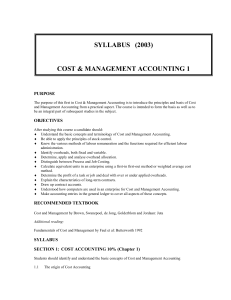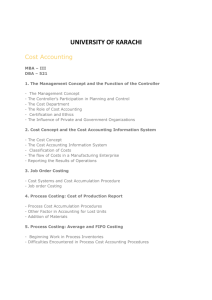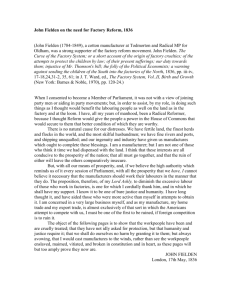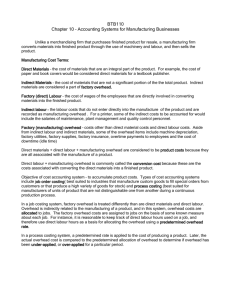Chapter 7 Costing
advertisement
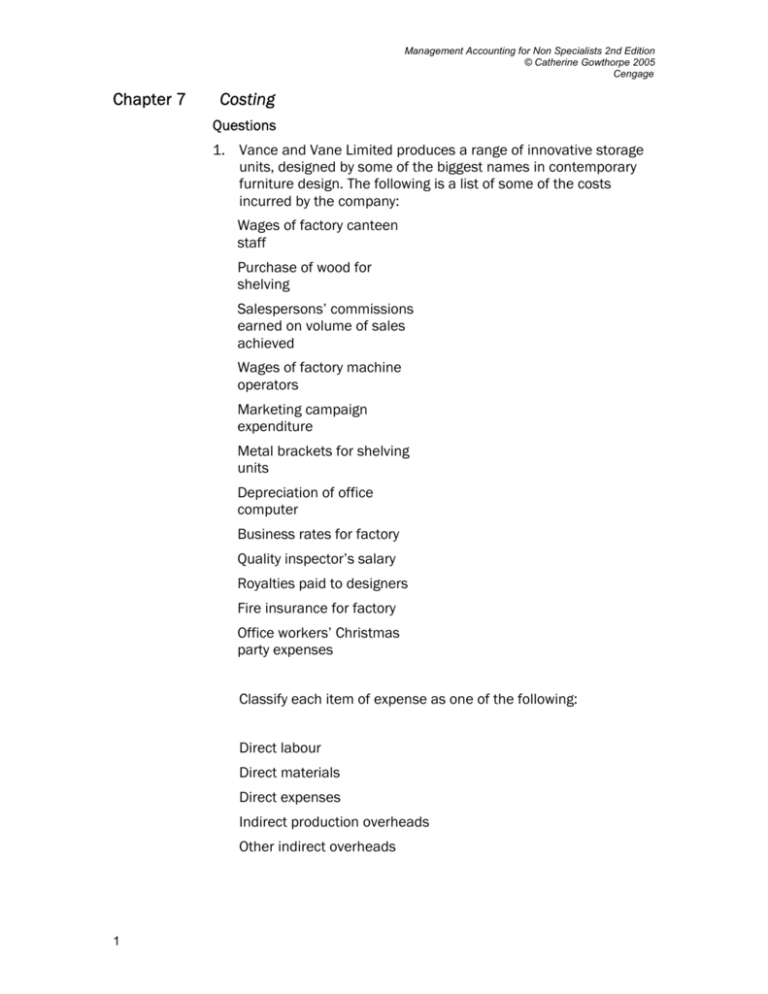
Management Accounting for Non Specialists 2nd Edition © Catherine Gowthorpe 2005 Cengage Chapter 7 Costing Questions 1. Vance and Vane Limited produces a range of innovative storage units, designed by some of the biggest names in contemporary furniture design. The following is a list of some of the costs incurred by the company: Wages of factory canteen staff Purchase of wood for shelving Salespersons’ commissions earned on volume of sales achieved Wages of factory machine operators Marketing campaign expenditure Metal brackets for shelving units Depreciation of office computer Business rates for factory Quality inspector’s salary Royalties paid to designers Fire insurance for factory Office workers’ Christmas party expenses Classify each item of expense as one of the following: Direct labour Direct materials Direct expenses Indirect production overheads Other indirect overheads 1 Management Accounting for Non Specialists 2nd Edition © Catherine Gowthorpe 2005 Cengage 2. Wellingborough Cravats Limited produces high quality silk ties. In the month ending 30 November 20X4 the company incurs the following costs: £ Depreciation of weaving machines 610 Secretarial and administrative salaries 3 373 Silk thread 6 866 Office supplies 861 Presentation packaging for ties 433 Factory supervisors’ wages 1 604 Depreciation of office computer 82 Labels for ties 121 Other factory costs 1 080 Advertising 650 Weaving machine operators’ wages 6 620 Factory cleaning 260 Repairs and maintenance of factory 676 Selling costs 1 270 Electricity (see note) 1 025 Factory rental and rates 1 665 Note: 80% of the electricity charge relates to the factory and 20% to the office. Required: rearrange the information given into a cost statement for the month ending 30 November 20X4. 3. Zane and Aldiss Limited produces custom-built yachts for the seriously wealthy. The company uses a job costing system to accumulate costs for each yacht built. In the month of June 20X7 the company has three yachts at various stages of assembly in its dry dock. Accumulated costs to 1 June 20X7 for each yacht are as follows: Direct material 2 Yacht ref: X0/22 Yacht ref: X0/24 Yacht ref: X0/27 £ £ £ 6 625 1 030 1 850 Management Accounting for Non Specialists 2nd Edition © Catherine Gowthorpe 2005 Cengage Direct labour 2 070 663 1 200 During June 20X7 the following transfers from stores are made: Quantity Value per unit Job no Mahogany strip 120 metres £16 per metre X0/22 Pine strip 80 metres £3.50 per metre X0/24 Metal fixing components 60 units £0.80 per unit X0/27 Metal fixing components 84 units £0.75 per unit X0/24 Metal fixing components 104 units £1.00 per unit X0/22 The value of other sundry materials booked to each job is as follows: X0/22 £610 X0/24 £552 X0/27 £1 003 The input of the four different grades of direct labour is as follows: Grade Number of hours Job no 4 16 X0/27 30 X0/22 28 X0/24 106 X0/27 88 X0/22 78 X0/24 54 X0/22 60 X0/27 3 2 1 The total cost to the company of the various grades of direct labour, per hour, is: 3 Grade 4 £12.50 Grade 3 £10.00 Grade 2 £9.50 Grade 1 £9.00 Management Accounting for Non Specialists 2nd Edition © Catherine Gowthorpe 2005 Cengage Required: design a job costing form which records the material and labour costs for each yacht up to the end of June 20X7. The form should show an accumulated prime cost total for each yacht at the end of June 20X7. 4. Amis Brevel Biscuits Limited has three principal departments in its production process: mixing, baking and packaging. In April 20X2 the company incurs the following production overheads which it plans to allocate and apportion as follows between its three departments: £ Factory rental and business rates Basis of apportionment 7 910 Floor area 910 Floor area Factory cleaning Supervisory salaries 18 400 No. of employees Other indirect labour 14 210 Floor area Electricity 6 560 Actual 632 Actual Building maintenance Insurance 1 064 Machinery depreciation 370 Total Floor area Machinery net book value 50 056 The following information is relevant for the apportionment of overheads: Total Mixing Baking Packaging Floor area 7 000 sq. m. 2 500 sq. m. 2 500 sq. m. 2 000 sq. m. Employees 16 6 4 6 Machinery NBV £44 400 £18 240 £20 040 £6 120 Electricity £6 560 £2 160 £3 104 £1 296 Building maintenance £632 £360 - £272 Required: produce a schedule apportioning the overheads between the three departments (cost centres). 4 Management Accounting for Non Specialists 2nd Edition © Catherine Gowthorpe 2005 Cengage 5. Bayleaf Manufacturing and Trading Company Limited produces several kitchen products, one of which is a bayleaf grinder. One bayleaf grinder has a prime cost of £2.20, which includes 10 minutes of direct labour (costed at £7.20 per hour). Each unit uses 15 minutes of machine time. The company’s management accountant has estimated the following totals for the coming financial year, 20X9: Machine hours available in the factory 20 000 hours Direct labour hours available 40 000 hours Total production overheads £120 000 What is the estimated production cost of one bayleaf grinder if (a) production overheads are absorbed on the basis of machine hours? (b) production overheads are absorbed on the basis of labour hours? 6. Combe Cullen Systems Limited manufactures two products in its Oldfield division. Traditionally the company has used an overhead absorption system based on machine hours. However, following a management consultancy exercise in which outside consultants reviewed the management information systems, the directors have decided to pilot an activity-based costing (ABC) system at the Oldfield factory. For the coming year, 20X6, Oldfield’s production overheads are estimated as follows: £ Factory rent and rates 42 200 Heat and light to factory 23 950 Factory insurance Supervisory salaries 38 540 Other indirect labour 18 030 Canteen charges 5 7 100 6 100 Machinery depreciation 18 000 Machinery maintenance 5 520 Production consumables (e.g. machine oil) 2 050 Other factory costs 7 480 Management Accounting for Non Specialists 2nd Edition © Catherine Gowthorpe 2005 Cengage Total 168 970 Following a detailed review of the production processes, the finance director and the divisional accountant identify a set of key cost drivers, together with cost allocations to each, and estimates of the relevant quantities involved for products A and B in the 20X6 financial year: Activity Cost driver Total Product A Product B Total cost per cost driver 6 000 5 000 11 000 6 000 5 000 63 030 £ Planned units of production Machining Machine hours Assembly Labour hours 9 000 3 000 6 000 43 020 Packing Labour hours 4 000 2 000 2 000 31 000 Materials ordering No. of orders 111 86 25 9 990 Materials issues No. of issues 150 103 47 12 000 Machine set up Number of hours used in set up 33 25 8 5 940 Quality inspection Number of inspections 35 10 25 3 990 Total 168 970 Each planned unit of production of both product A and product B uses one machine hour. One unit of A has a prime cost of £12.50, while one unit of B has a prime cost of £16.00. Required: 6 (a) calculate the overhead absorption rate based on the company’s traditional system of using machine hours as a basis for overhead absorption (b) calculate the overhead per unit of product A and product B using the data provided for the new ABC system Management Accounting for Non Specialists 2nd Edition © Catherine Gowthorpe 2005 Cengage (c) calculate the production cost of one unit of product A and one unit of product B under both the old and the new costing systems (d) comment on the difference between the production costs for each product under the old and the new costing systems Work to two decimal places (i.e. the nearest penny). 7 Management Accounting for Non Specialists 2nd Edition © Catherine Gowthorpe 2005 Cengage Answers 1. Vance and Vane Limited Wages of factory canteen staff Indirect production overheads Purchase of wood for shelving Direct materials Salespersons’ commissions earned on volume of sales achieved Other indirect overheads Wages of factory machine operators Direct labour Marketing campaign expenditure Other indirect overheads Metal brackets for shelving units Direct materials Depreciation of office computer Other indirect overheads Business rates for factory Indirect production overheads Quality inspector’s salary Indirect production overheads Royalties paid to designers Direct expenses Fire insurance for factory Indirect production overheads Office workers’ Christmas party expenses Other indirect overheads 2. Wellingborough Cravats Limited Cost statement for November 20X4 £ £ Direct materials Silk thread 6 866 Labels for ties 121 Presentation packaging for ties 433 7 420 Direct labour Weaving machine operators’ wages 6 620 Prime cost 14 040 Production overheads Depreciation of weaving machines 610 Repairs and maintenance of factory 676 Factory rental and rates 8 1 665 Management Accounting for Non Specialists 2nd Edition © Catherine Gowthorpe 2005 Cengage Electricity (80% × £1 025) 820 Factory cleaning 260 Factory supervisors’ wages 1 604 Other factory costs 1 080 6 715 Production cost 20 755 Other overheads Secretarial and administrative salaries 3 373 Office supplies 861 Selling costs 1 270 Advertising 650 Electricity for office 205 Depreciation of office computer 82 6 441 Total costs 27 196 3. Zane and Aldiss Limited Job costing record – June 20X7 Direct material Brought forward Mahogany 120 × £16 Pine 80 × £3.50 Metal fixings: 60 × £0.80 84 × £0.75 104 × £1.00 Sundry materials Materials carried forward Direct labour Brought forward Grade 4 16 × £12.50 9 Job ref: X0/22 £ Job ref: X0/24 £ Job ref: X0/27 £ 6 625 1 920 1 030 1 850 280 48 63 104 610 9 259 552 1 925 1 003 2 901 2 070 663 1 200 200 Management Accounting for Non Specialists 2nd Edition © Catherine Gowthorpe 2005 Cengage 375 30 × £12.50 Grade 3 28 × £10.00 106 × £10.00 Grade 2 88 × £9.50 78 × £9.50 Grade 1 54 × £9.00 60 × £9.00 Labour carried forward 3 767 1 684 540 3 000 Prime cost Materials carried forward Labour carried forward Prime cost carried forward 9 259 3 767 13 026 1 925 1 684 3 609 2 901 3 000 5 901 280 1 060 836 741 486 4. Amis Brevel Biscuits Limited Cost Centre Basis Total Mixing Baking Packaging £ £ £ £ Factory rental/rates Floor area 7 910 2 825 2 825 2 260 Factory cleaning Floor area 910 325 325 260 Supervisory salaries No. of employees 18 400 6 900 4 600 6 900 Other indirect labour Floor area 14 210 5 075 5 075 4 060 Electricity Actual 6 560 2 160 3 104 1 296 Building maintenance Actual 632 360 - 272 Insurance Floor area 1 064 380 380 304 Machinery depreciation Machinery NBV 370 152 167 51 50 056 18 177 16 476 15 403 Totals 5. Bayleaf Manufacturing and Trading Company Limited (a) Overheads absorbed on a machine hours basis: The overhead absorption rate is: £120 000 10 = £6 per machine hour Management Accounting for Non Specialists 2nd Edition © Catherine Gowthorpe 2005 Cengage 20 000 The production cost of one bayleaf grinder is: Prime cost 2.20 Overhead (£6.00 × 15mins/60 mins) 1.50 £3.70 (b) Overheads absorbed on a labour hours basis The overhead absorption rate is: £120 000 = £3.00 per machine hour 40 000 The production cost of one bayleaf grinder is: Prime cost 2.20 Overhead (£3.00 × 10mins/60 mins) 0.50 £2.70 6. Combe Cullen Systems Limited (a) Overhead absorption rate based on machine hours Estimate of production overheads for 20X6: £168 970 Total machine hours = 11 000 Rate per machine hour = £168 970 = £15.36 per hour 11 000 (b) Overhead per unit using ABC system Cost per unit of cost driver: Activity Machining Cost amount £ Overhead Machine hours Assembly Overhead Labour hours 11 = 63 030 £5.73 per machine hour 11 000 = 43 020 9 000 £4.78 per labour hour Management Accounting for Non Specialists 2nd Edition © Catherine Gowthorpe 2005 Cengage Packing Overhead = 31 000 Labour hours Materials ordering Overhead Materials issue Overhead 4 000 = 9 990 No. of orders Overhead = 12 000 Overhead £80 per issue 150 = 5 940 No of hours Quality inspection £90 per order 111 No. of issues Machine set up £7.75 per labour hour £180 per hour 33 = 3 990 No of inspections £114 per inspection 35 Allocation of overhead between product A and product B: Product A Product B £ £ Machining 6000 × £5.73 34 380 5000 × £5.73 28 650 Assembly 3000 × £4.78 14 340 6000 × £4.78 28 680 Packing 2000 × £7.75 15 500 2000 × £7.75 15 500 Materials ordering 86 × £90 7 740 25 × £90 2 250 Materials issues 103 × £80 8 240 47 × £80 3 760 Machine set up 25 × £180 4 500 8 × £180 1 440 Quality inspection 10 × £114 1 140 25 × £114 2 850 Total (c) 85 840 83 130 Production cost of one unit of each product under ABC system A B Total production overhead £85 840 £83 130 Number of units planned for production 6 000 5 000 Production overhead per unit £14.31 £16.63 Prime cost per unit 12.50 16.00 Production cost per unit 26.81 32.63 Production cost of one unit of each product under the old costing system 12 Management Accounting for Non Specialists 2nd Edition © Catherine Gowthorpe 2005 Cengage Prime cost per unit £12.50 £16.00 Production overhead for one machine hour 15.36 15.36 Production cost per unit 27.86 29.36 (d) Under both systems the production cost of A is less than the production cost of B. However, there is a greater difference between A and B under the ABC system of costing: A’s cost is lower under ABC whereas B’s cost is higher. Although product A involves a much higher number of materials orders and issues and higher machine set up costs, this is more than offset by the key factor which is the much lower number of labour hours involved in the assembly of product A. Because the company has traditionally absorbed production costs via machine hours, the much lower input of labour hours into A’s assembly has been ignored. One of the advantages of the ABC system is that it is much more ‘fine-tuned’ in this respect. However, it should be noted that a great deal of work has been involved in collecting and analysing the data relating to production. Some might argue that the benefit of the more accurate cost provided by ABC is more than offset by the high cost of collecting the relevant data. 13

